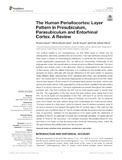Mostrar el registro sencillo del ítem
The human periallocortex: layer pattern in presubiculum, parasubiculum and entorhinal cortex. A review
| dc.creator | Insausti, Ricardo | es_ES |
| dc.creator | Muñoz López, Mónica | es_ES |
| dc.creator | Insausti Serrano, Ana María | es_ES |
| dc.creator | Artacho Pérula, Emilio | es_ES |
| dc.date.accessioned | 2018-09-04T06:43:48Z | |
| dc.date.available | 2018-09-04T06:43:48Z | |
| dc.date.issued | 2017 | |
| dc.identifier.issn | 1662-5129 (Electronic) | |
| dc.identifier.uri | https://hdl.handle.net/2454/30434 | |
| dc.description.abstract | The cortical mantle is not homogeneous, so that three types of cortex can be distinguished: allocortex, periallocortex and isocortex. The main distinction among those three types is based on morphological differences, in particular the number of layers, overall organization, appearance, etc., as well as its connectivity. Additionally, in the phylogenetic scale, this classification is conserved among different mammals. The most primitive and simple cortex is the allocortex, which is characterized by the presence of three layers, with one cellular main layer; it is continued by the periallocortex, which presents six layers, although with enough differences in the layer pattern to separate three different fields: presubiculum (PrS), parasubiculum (PaS), and entorhinal cortex (EC). The closest part to the allocortex (represented by the subiculum) is the PrS, which shows outer (layers I–III) and inner (V–VI) principal layers (lamina principalis externa and lamina principalis interna), both separated by a cell poor band, parallel to the pial surface (layer IV or lamina dissecans). This layer organization is present throughout the anterior-posterior axis. The PaS continues the PrS, but its rostrocaudal extent is shorter than the PrS. The organization of the PaS shows the layer pattern more clearly than in the PrS. Up to six layers are recognizable in the PaS, with layer IV as lamina dissecans between superficial (layers I–III) and deep (V–VI) layers, as in the PrS. The EC presents even more clearly the layer pattern along both mediolateral and rostrocaudal extent. The layer pattern is a thick layer I, layer II in islands, layer III medium pyramids, layer IV as lamina dissecans (not present throughout the EC extent), layer V with dark and big pyramids and a multiform layer VI. The EC borders laterally the proisocortex (incomplete type of isocortex). Variations in the appearance of its layers justify the distinction of subfields in the EC, in particular in human and nonhuman primates. EC layers are not similar to those in the neocortex. The transition between the periallocortical EC and isocortex is not sharp, so that the proisocortex forms an intervening cortex, which fills the gap between the periallocortex and the isocortex. | en |
| dc.format.extent | 10 p. | |
| dc.format.mimetype | application/pdf | en |
| dc.language.iso | eng | en |
| dc.publisher | Frontiers Media | en |
| dc.relation.ispartof | Frontiers in Neuroanatomy, 11: 84 | en |
| dc.rights | © 2017 Insausti, Muñoz-López, Insausti and Artacho-Pérula. This is an open-access article distributed under the terms of the Creative Commons Attribution License (CC BY). The use, distribution or reproduction in other forums is permitted, provided the original author(s) or licensor are credited and that the original publication in this journal is cited, in accordance with accepted academic practice. No use, distribution or reproduction is permitted which does not comply with these terms. | en |
| dc.rights.uri | https://creativecommons.org/licenses/by/4.0/ | |
| dc.subject | Human | en |
| dc.subject | Entorhinal cortex | en |
| dc.subject | Presubiculum | en |
| dc.subject | Parasubiculum | en |
| dc.subject | Layer pattern | en |
| dc.title | The human periallocortex: layer pattern in presubiculum, parasubiculum and entorhinal cortex. A review | en |
| dc.type | info:eu-repo/semantics/article | en |
| dc.type | Artículo / Artikulua | es |
| dc.contributor.department | Ciencias de la Salud | es_ES |
| dc.contributor.department | Osasun Zientziak | eu |
| dc.rights.accessRights | info:eu-repo/semantics/openAccess | en |
| dc.rights.accessRights | Acceso abierto / Sarbide irekia | es |
| dc.identifier.doi | 10.3389/fnana.2017.00084 | |
| dc.relation.publisherversion | https://doi.org/10.3389/fnana.2017.00084 | |
| dc.type.version | info:eu-repo/semantics/publishedVersion | en |
| dc.type.version | Versión publicada / Argitaratu den bertsioa | es |
Ficheros en el ítem
Este ítem aparece en la(s) siguiente(s) colección(ones)
La licencia del ítem se describe como © 2017 Insausti, Muñoz-López, Insausti and Artacho-Pérula. This is an open-access article distributed under the terms of the Creative Commons Attribution License (CC BY). The use, distribution or reproduction in other forums is permitted, provided the original author(s) or licensor are credited and that the original publication in this journal is cited, in accordance with accepted academic practice. No use, distribution or reproduction is permitted which does not comply with these terms.



